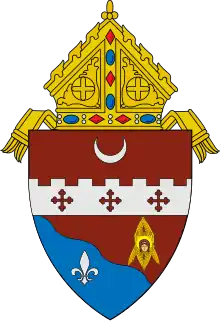Our Sunday Visitor
Our Sunday Visitor is a Roman Catholic publishing company in Huntington, Indiana, which prints the American national weekly newspaper of that name, as well as numerous Catholic periodicals, religious books, pamphlets, catechetical materials, inserts for parish bulletins and offertory envelopes, and offers an "Online Giving" system and "Faith in Action" websites for parishes.[1] Founded in 1912 by Father John F. Noll, the newspaper Our Sunday Visitor was the most popular Catholic newsweekly of the twentieth century.[2]
| Founded | 1912 |
|---|---|
| Founder | John F. Noll |
| Country of origin | United States |
| Headquarters location | Huntington, Indiana |
| Publication types | newspapers, magazines, books, pamphlets, offertory envelopes |
| Official website | osv |
History

John Francis Noll, later Bishop of Fort Wayne in Indiana, was a small town priest who, having grown weary of anti-Catholic literature, and especially a widely circulated anti-Catholic paper called The Menace, decided to print a parish bulletin. The first issue of Our Sunday Visitor, numbering 35,000 copies, was dated May 5, 1912. A year later, the circulation of the paper had reached 160,000 copies, far beyond Noll's parish. Shortly after World War I, the circulation had grown to 500,000 copies.[3]
The initial focus of Our Sunday Visitor was to combat anti-Catholicism, help Catholics preserve their identity, teach Catholics about their faith, and combat social injustice. A column Noll started in 1912, called "Father Smith Instructs Jackson", was later collected into a popular book, which sold millions of copies.[3]
On March 30, 1913, the paper offered a $10,000 reward for anyone who could prove the anti-Catholic charges laid against the Church. No one ever claimed the reward.[3]
In the 1930s, Our Sunday Visitor focused on how Catholics could preserve their faith in a secular society. During the 1940s, Noll's newspaper took positions against birth control, divorce, and indecent literature and movies.[3]
During the Cold War, the paper stepped up its attacks on communism and warned Catholics away from joining communist groups. The fortieth anniversary issue of Our Sunday Visitor, published on May 4, 1952, carried a banner headline that read, "They Do Not Want God in Our Schools: Secular Trend is Certain to Bring Disaster."[3]
In 1953, Noll was named archbishop ad personam by Pope Pius XII. Noll suffered a stroke in 1954 and was no longer able to edit Our Sunday Visitor. He died on July 31, 1956.[3]
After Noll's death, the paper continued to be produced, and in 1961 its circulation had surpassed one million. Today, Our Sunday Visitor has a full publishing wing which publishes books, religious educational materials, and other media.[3] The company expanded by purchasing Harcourt Religion in 2009.[4] As of 2019 the Our Sunday Visitor weekly newspaper is known as OSV Newsweekly and the editor-in-chief is Gretchen R. Crowe;[5] earlier it was known as OSV Weekly.
In July 2012, the Sunday Visitor was selected by the Vatican as the exclusive distributor of the North American English edition of the official Vatican newspaper, L'Osservatore Romano (The Roman Observer).[6]
References
- "Our Sunday Visitor Publishing Company". Our Sunday Visitor. Retrieved July 9, 2018.
- "Founding of the Our Sunday Visitor". CatholicHistory.net. Archived from the original on September 8, 2015. Retrieved March 30, 2019.
- "'To Serve the Church'". Our Sunday Visitor. Archived from the original on February 6, 2012. Retrieved July 9, 2018.
- "A New Day in Catechesis - Our Sunday Visitor Acquires Harcourt Religion Publishers from Houghton Mifflin Harcourt". PRWeb. June 5, 2009. Retrieved March 30, 2019.
- "About". OSV Newsweekly. Retrieved May 26, 2019.
- Washington Post (July 25, 2012). "Vatican newspaper begins new distribution deal in US in bid to broaden subscriber base". CathNews USA. Retrieved March 30, 2019.
